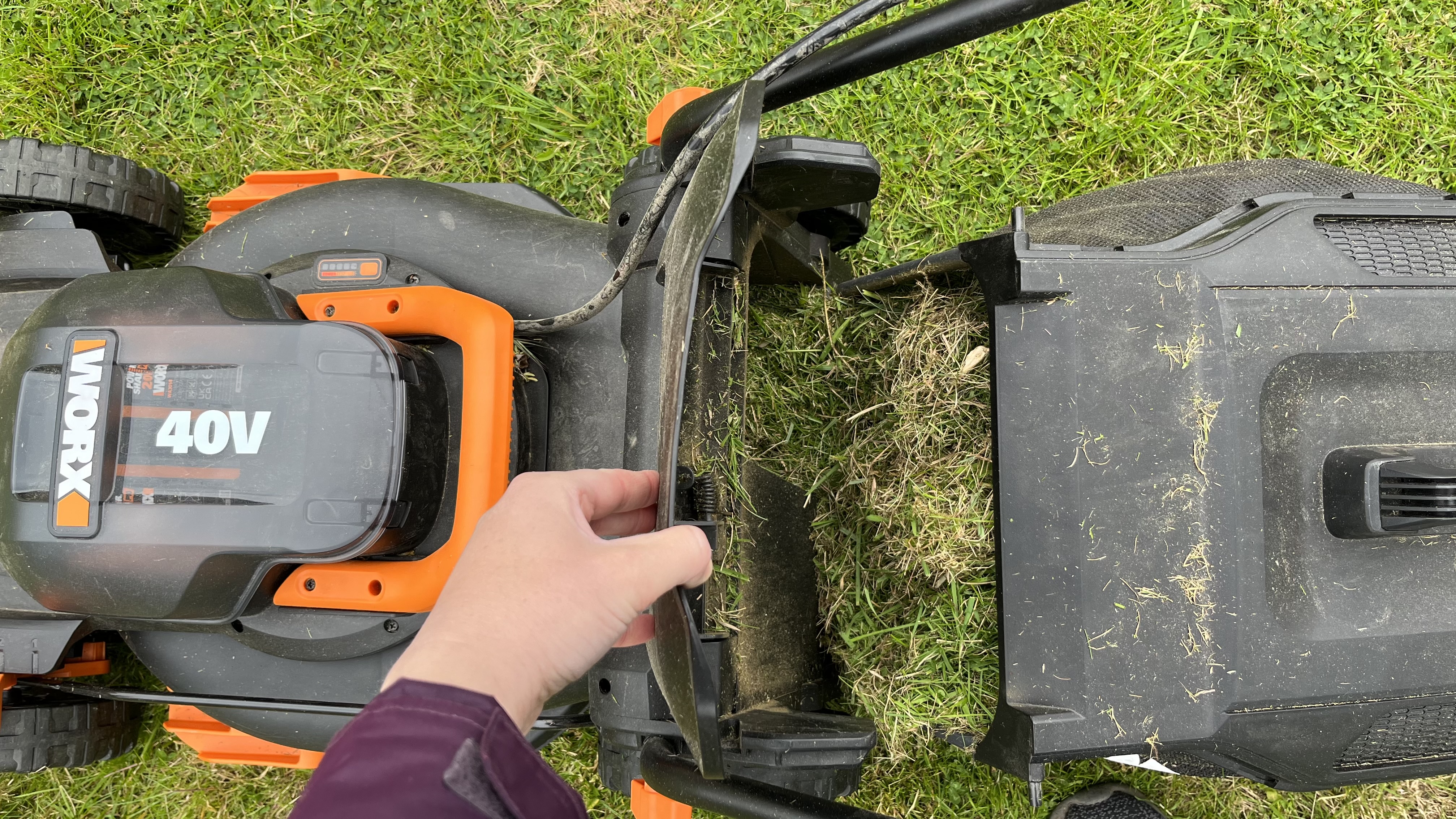9 things NOT to do to your lawn mower
Know what NOT to do to your lawn mower to keep it running and your lawn in-tact

- 1. Don't mow things that aren't grass
- 2. Don't have the blade height too low
- 3. Don't let it be exposed to the elements
- 4. Don't mow wet grass
- 5. Don't forget to sharpen the blades
- 6. Don't forget about the filter
- 7. Don't leave the battery in over winter
- 8. Don't let the grass cuttings bag get stuff
- 9. Don't neglect the servicing
Owning one of the best lawn mowers comes with some responsibility, which includes using it correctly and maintaining it beyond the obvious battery recharge.
We often discuss how to use and maintain a lawn mower, but we rarely mention the things to avoid. I feel that it is good to have the balance of what to do and what not to do all written down for reference because, sometimes, it can be forgotten or sidelined for something considered more of a priority.
Armed with some knowledge (clumsy experience) and top tips from lawn care and mower experts, these are the nine things NOT to do to your lawn mower so that you can look after your investment in the machine and the yard.
9 things NOT to do to your lawn mower
1. Don't mow things that aren't grass
The clue is in the name: lawn mower. These machines are only built to mow the lawn. Any laundry pegs, stones, glass, and anything else you may run over on the lawn could damage the mower blade. This will cost you money. There's also a chance that mowing things that aren't grass will damage you, as small shards are thrown out from the deck into your path.
Before cutting the grass, the best thing to do is to always check the mow areas for obstacles and tough debris and remove them. This way, you'll be clearing the area (while tidying up) to make way for your lawn mower.
2. Don't have the blade height too low
Setting the correct blade height will ensure you achieve the perfect length for your grass. It'll also ensure an even cut across the designated area and prevent the blade from getting damaged.
Yes, having the blade height too low on your mower will dig it into the ground. Over time, this could damage the blade by taking small chunks out of it and allowing rust to set in. A low blade setting could also impact the grass-cutting experience since many mowers will now cut out as a safety precaution if the blade becomes stuck.
Sign up to receive the latest news, reviews, buying guides and deals direct to your inbox

3. Don't let it be exposed to the elements
Rain, sunlight, wind, and freezing temperatures can all affect the mechanics of the lawn mower over time. For example, frost damage could affect the electronics and/or charging performance if you have a robot lawn mower, so it would always be wise to invest in a garage for it. For example, the WORX WA0810 Landroid Garage with Flip-up Cover ($169.99 on Amazon) provides some shelter and UV protection from extreme weather conditions.
Equally, if you don't have a garage or suitable shelter for your push or riding lawn mower, then either covers by particular manufacturers are available, or universal covers can be bought from Amazon for as little as $14.
4. Don't mow wet grass
Mowing wet grass with your lawn mower risks damaging it and your lawn. Clumps of grass will clog the mower, and blades exposed to water over a long period of time could induce rust. The mower will also need to work harder in these slippery conditions, putting it under some strain.
“When wet, a lawn mower will slip and tear the grass if the blade isn't very sharp,” explains Marc Kerr, lawn specialist and co-founder of So & Mo. He adds, “If you mow the lawn when it's wet, you won't get a clean cut the first time around. In most cases, you'll need to double-cut it for an even finish.”

5. Don't forget to sharpen the blades
If neglected, lawn mower blades can cause long-term damage to the machine and the grass. This means that it is vital to know how to sharpen lawn mower blades, which can (honestly) be done in four easy steps.
Calum Maddock from HomeHow.co.uk says, "The blade of your mower cuts the grass, so it’s critical to keep it sharp, balanced, and in good overall condition. Dull blades don’t cut cleanly or smoothly, and the mower has to work harder, thereby shortening its working life.
"Checking the blade regularly allows you to assess when it needs sharpening and if it’s been damaged by stones or other hard objects. Replacing the blade once a year is recommended. "
David Gower, chairman of the Lawn Association, adds the impact that mowing with blunt blades can have on your grass: "When we cut or mow grass with a blunt blade, it tears the grass blades, causing the grass to turn dull at the end, of the tips. Do this all over your lawn, and you instantly lose the color. It will then struggle to take in food and water and ultimately be unhealthy….’’

Calum Maddock is a UK-based landscaper with over fifteen years of experience in the industry. As a gardening expert for HomeHow, Calum offers his expert advice to tradespeople and homeowners around the globe and has been featured as a gardening expert for a range of reputable publications.
6. Don't forget about the filter
The air filter in your gas lawn mower must be replaced to ensure a smooth start-up and continued power. Failing to do this to your lawn mower could lead to problems.
Ryan Patterson, Residential Segment Manager at Husqvarna, says: “Regularly replacing the air filter is crucial, especially in dusty conditions. A damaged filter can lead to problems with starting your lawn mower and a noticeable loss of power during use. Therefore, depending on usage, it should be replaced every three months or once a season.”
Locate the air filter cover on your lawn mower and take it off. If you have a paper filter, knock the filter on a solid surface to eliminate dust. If you have a foam filter, remove it and wash it in warm, soapy water. Squeeze out the water, leave to dry, and replace. Make sure it is fitted properly. If the air filter is damaged, worn, or still dirty after cleaning, you need to replace it.

Ryan Patterson is the Residential Segment Manager at Husqvarna's Forest & Garden Division, leading the introduction of outdoor power products to the residential UK market, including chainsaws, grass trimmers, and the market-leading Husqvarna Automower. With previous experience in the consumer technology and AV industry, Ryan has worked on bringing several award-winning tech products to market for several global tech brands.
7. Don't leave the battery in over winter
Storing the lawn mower for winter is good lawn mower maintenance. One of the easiest and most obvious things to do ahead of this is to remove the battery, yet this is something that could be quite equally missed.
If lithium-ion batteries power your lawn mower, then it would be best to remove them and store them in a sealed box where it won’t get extremely cold. This could help to maintain good battery performance in the long run.
Similarly, if you have a gas-powered lawn mower, Maddock adds: "Petrol that sits in your lawn mower for more than a month can lead to clogging of the carburetor. The combustible elements in the fuel will evaporate over time and leave behind a thick residue that blocks the carburetor’s jets. If this happens, the old fuel should be drained and the carburetor cleaned to remove the blockages. To prevent this, drain any remaining fuel before storing your lawn mower for the winter and make sure it’s been serviced well. "

8. Don't let the grass cuttings bag get stuff
Buying Guides
Best cordless lawn mower: top battery-powered lawn mowers to tackle your yard
Reviews
Worx Landroid S WR165 review: an intermediate-level robot lawn mower
STIHL RM 655 VS Lawn Mower review: a premium gas lawn mower which is a cut above the rest
DeWALT DCMWSP244U2 Cordless Self-Propelled Mower review: an efficient, long-lasting tool
Dewalt DCMWP600X2 60V MAX Cordless Push Mower review: lightweight yet powerful
Husqvarna Automower 450XH review: a fantastic, if flawed, lawn buddy
Mammotion Luba 2 AWD 5000 review: a tech-heavy robot lawn mower for large yards
Segway Navimow i105N robot lawn mower review: smarter, simpler, superior?
For lawn mowers with a grass cuttings bag attached, don't forget to empty it. You'll have a better mowing experience with the bag emptied because it'll avoid you having to walk back over the lawn with a rake, and it won't weigh down the bag so much that the handle is at risk of breaking off when you do go to lift it.
Keeping the grass clippings bag clean will also help when it comes to storing the lawn mower. There's nothing much worse than getting out the lawn mower after being stored for a week, month, or year, and there's grass (etc!) that is more than just compost.

9. Don't neglect the servicing
This will help keep the lawn mower running smoothly and within its guarantee. Many warranties don't seem to cover general wear-and-tear, so it's best to keep on top of this to ensure that the machine lasts and that you continue to yield good cutting performance.
"Regular servicing will ensure that your lawn mower stays in good working condition and prolongs its life. Get an annual service or after every 50 hours of use, whichever happens first. It’s not just petrol mowers that need servicing; an electric mower should be checked for safety, and the blade sharpened or replaced. Servicing ride-on mowers is particularly important as they have many safety features which need to be regularly checked, including a cut-off switch if the driver gets off the seat. " says Maddock

Jennifer Oksien, Editor of Top Ten Reviews, writes about home and kitchen products. Based in the UK, she enjoys renovating her home, trying out new appliances, and savoring a cup of tea. With a background in journalism and marketing, she balances work with gardening, baking, and streaming her favorite series.
